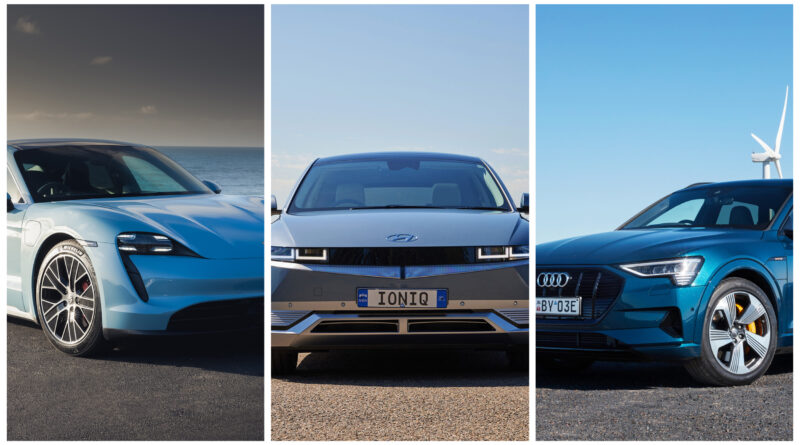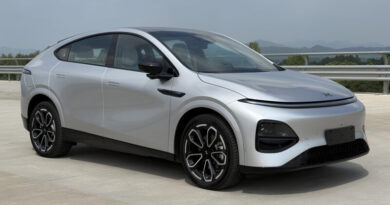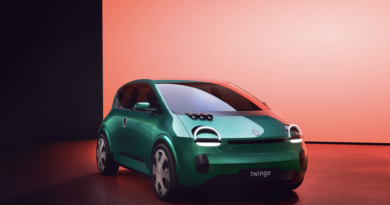EV charging race: Hyundai Ioniq 5 versus Porsche Taycan versus Audi e-Tron
We love a race here at EV Central. But this one’s a bit different. It’ll be happening while the cars are parked.
EV makers love telling you just how quick their vehicles will charge – and it’s often the peak charging power that leads the marketing hype. And it’s important – how fast your Hyundai, Porsche or Audi can pack in the power is directly related to how long you’ll be plugged into a roadside charger before you can get back on the road.
But as we know from charging the latest EVs at a range of chargers across the country, those peak numbers often don’t mean a whole lot.
No EV will accept that maximum DC charge rate across the entire charging time. Often, the peak is short and sweet.
So, we grabbed three of the fastest-charging EVs money can buy in 2021: the Porsche Taycan, Audi e-Tron and Hyundai Ioniq 5.
READ MORE: Hyundai Ioniq 5: Australia’s fastest (charging) EV put to the real-world test
READ MORE: What’s the difference between AC and DC charging?
Each was taken to a 350kW Tritium ultra-rapid charger. Not all cars were tested on the same day or same charger, but they got identical treatment and very similar ambient temperatures around the 20-degrees-Celcius bracket. Each was driven to the station and plugged in for charging within an hour of arriving.
Check out the video below for the full charging cycle. There’s nothing exciting about the footage – it shows the entire charge cycle – but it does track the high and lows of each car throughout the ultra-rapid charge.
Watts and volts
The Porsche and Hyundai can both take 800V of charge, which is, for now, a rarity in the EV space.
That’s double the voltage of most EVs, which means they can accept double the power, assuming the current (measured in amps) is unchanged.

The e-Tron can only take 400V of charge and, on paper, looks like the least well-prepared for this battle.
Its charging peak is 150kW, versus 270kW for the Porsche and about 230kW for the Hyundai (don’t believe the 350kW marketing claim, as we’ve demonstrated previously).
But a lot can happen when you’re charging, and that’s what we wanted to put to the test in this race for electrons rather than speed.
The target: 30-80 percent
Many charging claims use 10-80 percent as the benchmark for charging times.
For this test we’ve chosen to start at 30 percent state of charge (SOC) and stop the clock at 80 percent.
Why? Because that’s about what charge our trio of cars were at when we pulled up to a 350kW Tritium charger run by Chargefox.
Sure, it may disadvantage some, but it’s a relevant test that is representative of what many EVs owners may experience on a big trip. Honestly, how often will drivers wait until their vehicle is at just 10 percent before plugging in?
Audi e-Tron
In launching the e-Tron, Audi made a big deal of its charging speed, acknowledging that while it may not have the loftiest charging power peak (150kW), it can hold close to that peak for longer due to smart software and cooling systems.
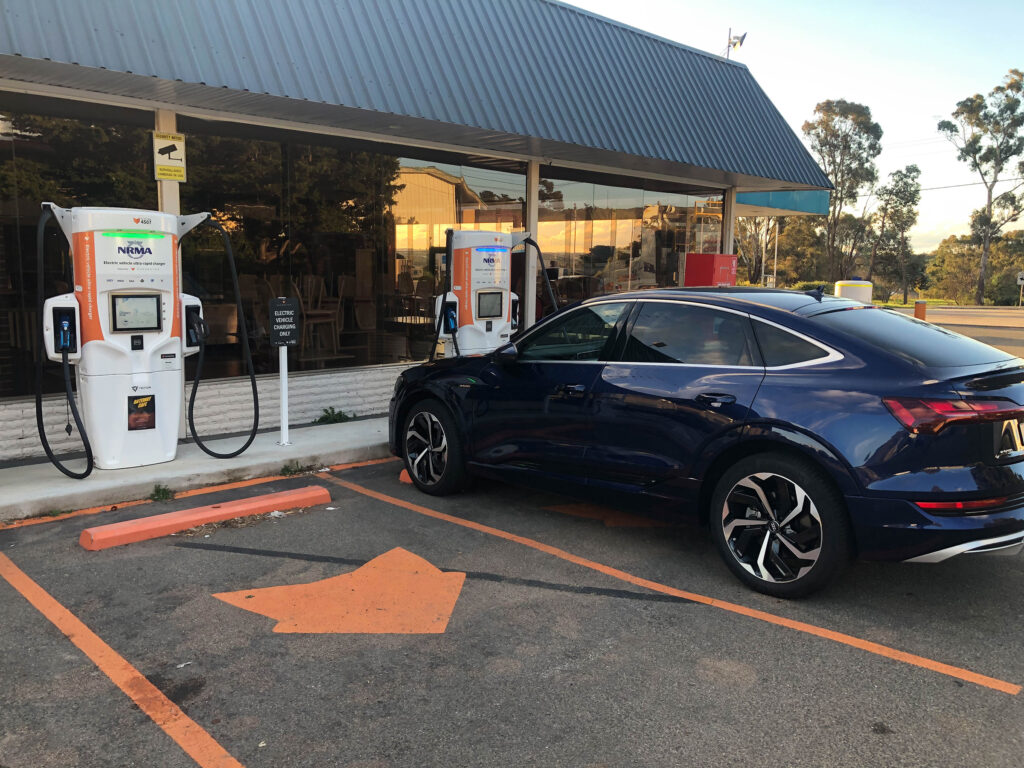
It’s the only one here that charges at up to 400V (the others are double that).
And guess what? It’s not all marketing hype.
From its 30 percent SOC start point it was immediately pulling in more than 140kW – close to its claimed peak. Topping up to 50 percent took less than seven minutes. That’s pretty damn good, right?
The e-Tron kept building its charging power gradually until it peaked at 153kW – 3kW above the claimed peak – at 70 percent SOC.
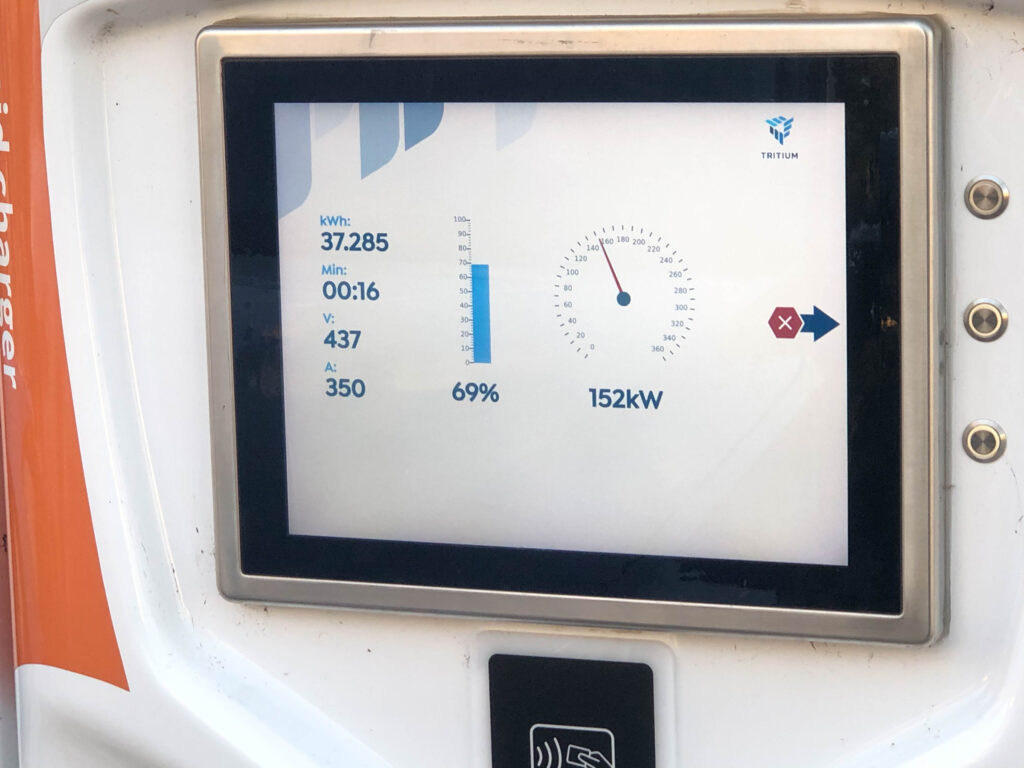
It held close to that charging peak until 79 percent SOC, at which point it started to drop more dramatically.
Still, having 140kW-plus constantly pumping into the battery pack made for a solid performance.
Porsche Taycan 4S
The Taycan claims a peak charging load of 270kW when you’re topping up the Performance Plus battery that was fitted to our car (225kW for the smaller battery).
But we wanted to see how realistic that peak was.
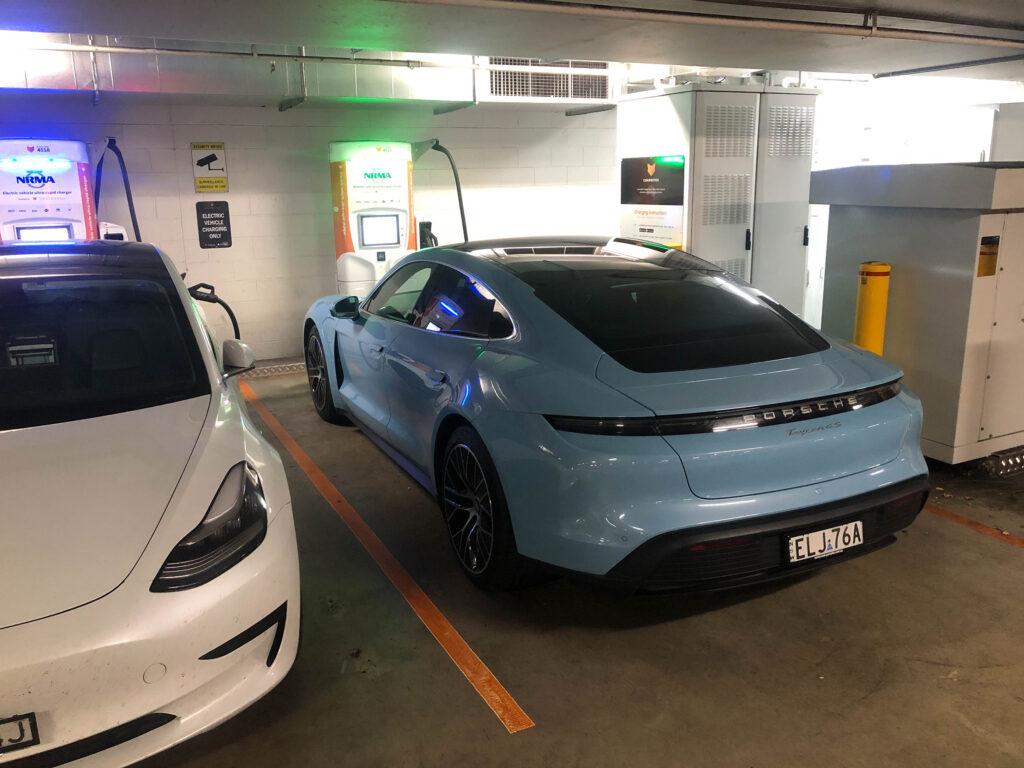
It’s challenged from the start with a big battery. At 93.4kWh the Taycan 4S requires more electricity to get it to our 80 percent SOC target. To top it up 70 percent (from 10-80 percent SOC) should theoretically require 65.4kWh of electricity, versus 60.6kWh for the Audi and 50.8kWh for the Hyundai.
Things started strongly with the Taycan drawing about 135kW from the start. It was a gradual build-up, eventually hitting 150kW at 42 percent SOC.
The Porsche peaked at 157kW at 55 percent SOC.

That’s well short of its claimed peak of 270kW. However, we’ve driven the Taycan in Germany and witnessed its fast charging previously touch 200kW when its SOC was below 30 percent. We suspect that will make a big difference, and is something we plan to test in future.
From there the Taycan charging rate dropped off by about 30 percent to between 100 and 110kW. It held that rate for the remainder of its charge.
Hyundai Ioniq 5
Our Ioniq 5 started its charging race on just 6 percent SOC. By the time it reached the 30 percent start point for this race it was already pulling in 220kW. Impressive.
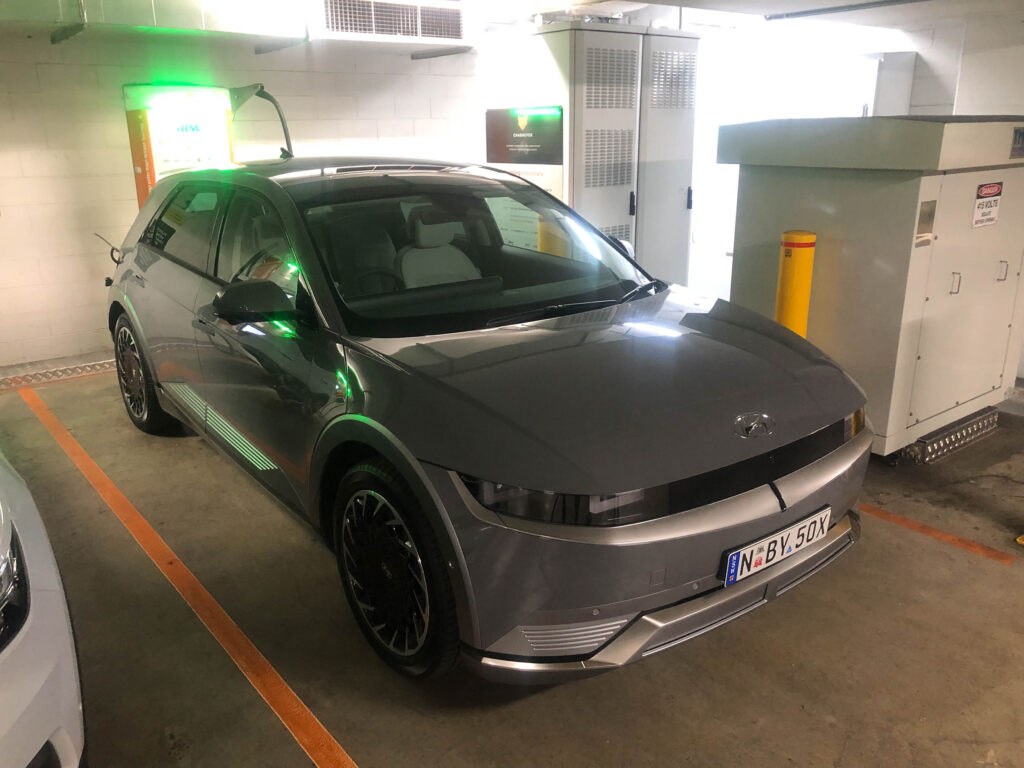
The Ioniq 5 hovered around that until hitting its 225kW peak at 53 percent SOC.
The excitement seemed too much because the Ioniq 5 then dropped to around 180kW by the time it reached 55 percent SOC.
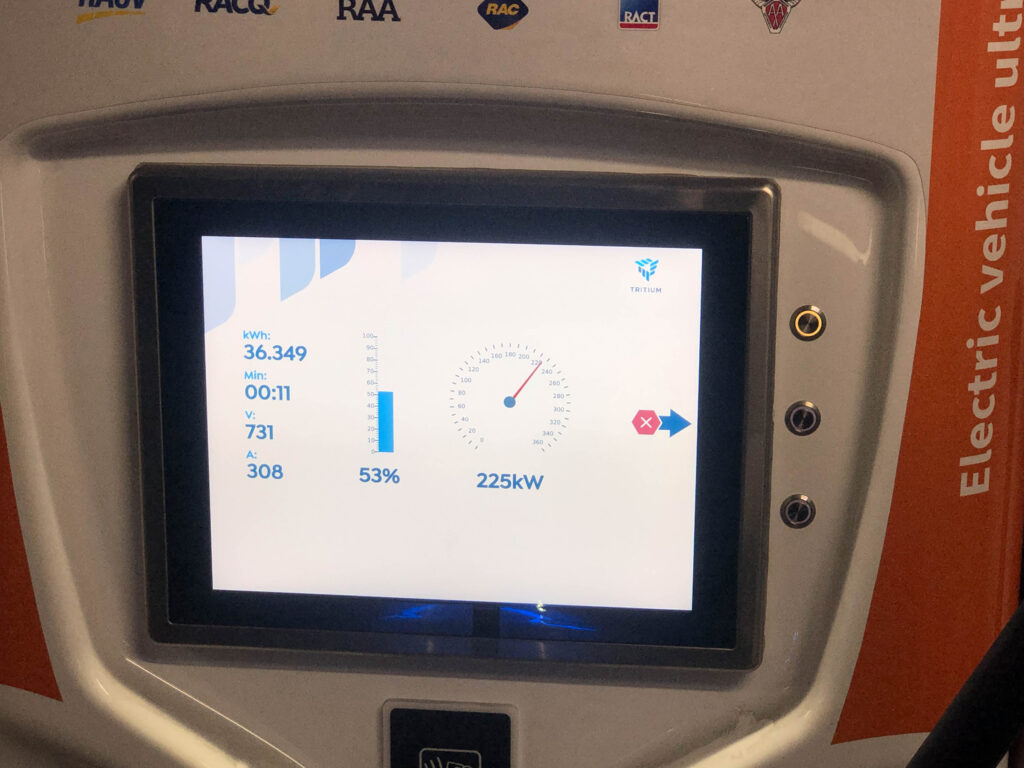
Charging power kept dropping but only fell below 150kW at 79 percent SOC – just as the Ioniq 5 was blasting to the 80 percent SOC finish line.
And the winner is…
For this 30-80 percent test the Hyundai Ioniq 5 is the fastest-charging EV on this test.
Same 350kW charger, same potential power and from the same state of charge (SOC) – and the Ioniq 5 was a clear winner.
It had a headstart in having a smaller battery to recharge. But the Ioniq 5 also accepted the highest peak power in this test (225kW) and the highest average power delivery across the charging race (186kW).
The total time for the 10-80 percent charge was just 12 minutes, 38 seconds.
Second place was the Audi e-Tron 55, which took 17 minutes, 34 seconds.
Impressively, the Audi held an average charge of 147kW across the charging race and was the only one to beat its claimed peak charging power, albeit by only 3kW (153kW).
The Porsche had the biggest battery to fill but never got close to its peak charging claim of 270kW. We suspect it will do its best work at a lower state of charge than our 30 percent start point; we’ll test that out another time.
Total time taken for the Taycan 4S was 21 minutes, 56 seconds and it accepted 46kWh of electricity, which was more than the other two.
| Claimed usable battery capacity | 30-80% charging time | Peak DC charging claim | Peak charging power | km/hour (peak) | Average power over 30-80% charge | km/hour (average) | Av. km of range added every 5 minutes | Max voltage | Electricity accepted | |
|---|---|---|---|---|---|---|---|---|---|---|
| Audi e-Tron 55 | 86.5kWh | 17 min, 34 sec | 150kW | 153kW | 695km/h | 147kW | 670km/h | 56km | 447V | 43.1kWh |
| Porsche Taycan 4S (with Performance Battery Plus) | 93.4kWh | 21 min, 56 sec | 270kW | 157kW | 581km/h | 126kW | 466km/h | 39km | 782V | 46.0kWh |
| Hyundai Ioniq 5 dual-motor | 72.6kWh | 12 min, 38 sec | 350kW | 225kW | 1184km/h | 186kW | 980km/h | 82km | 731V | 39.2kWh |
Real world charging versus claims
Our charging showdown proved the Ioniq 5 matches most of its claims, although the one about it being able to accept a 350kW charge seems out of reach. Because on our test, it couldn’t; 230kW seems closer to the money, and it seems Hyundai is merely advertising the car can accept a charge from a 350kW charger … which applies to any EV with DC charging capability.
Meanwhile Porsche’s 270kW peak charging power appears to be something that requires the right conditions on the right day – and our experience suggests it’s unlikely to maintain a charge near that peak for long. While it was still charging very fast – remember, the trio assembled here are among the fastest charging EVs on the planet – the Porsche’s average power consumption was 126kW.
We also crunched some fun facts, including the kilometre-per-hour figure (how much range is being added per hour expressed as km/h).
Again it was a solid win to the Hyundai, in part because it’s the lightest car here, so it uses less electricity. It peaked at 1184km/h for the dual-motor model (higher again if you have the single motor Ioniq 5 and recorded an average across the whole charge of 980km/h.
The e-Tron is second with a peak of 695km/h and average of 670km/h.
The Porsche is hurt by its big performance. It’s by far the fastest car here once you’re out on the road and that means higher electricity use. The peak charging rate was 581km/h and the average 466km/h. Still fast, but for this test the Taycan’s best work is done once the charging plug has been disconnected.
But the real winner is…
A little soppy, I know, but surely the real winner here is surely all of us. The fact that we have three very different EVs across three very different price brackets on this test, and each will accrue kilometres faster than you can say “I’m just ducking in for a coffee” goes to show just how convenient and easy to live with EV technology has become.
Even more exciting? That story is really only just beginning.

